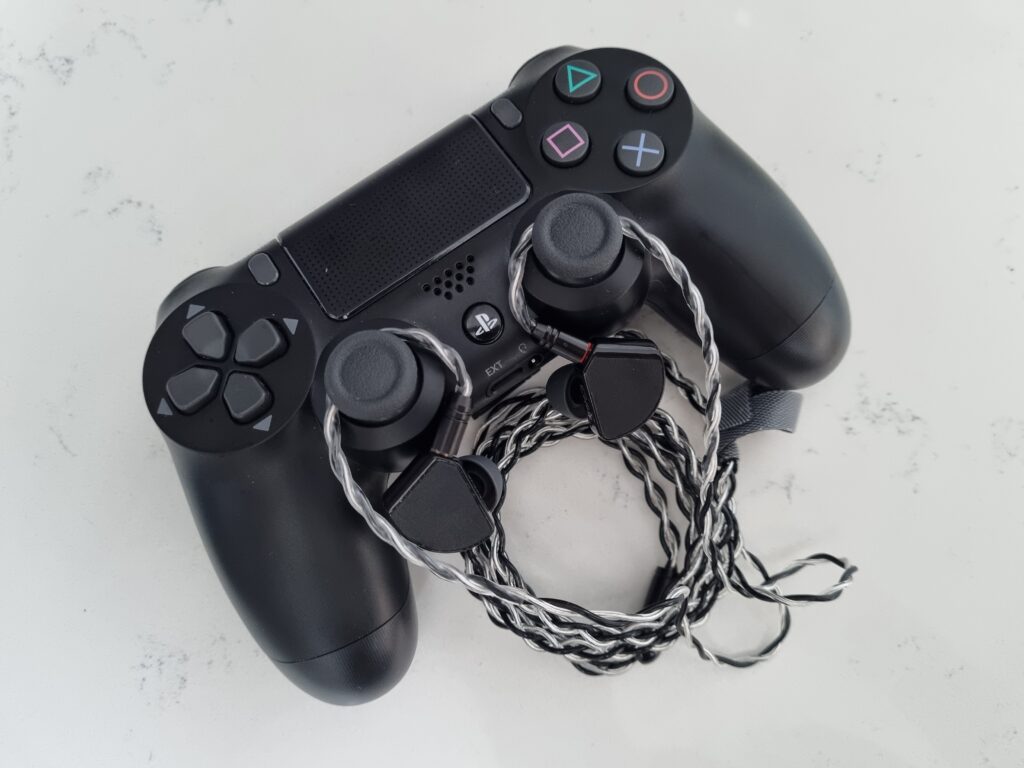Sound Summary

Note: For the entirety of the review, I have chosen to use the “Black” ear tips.
The Celeste Gumiho traces an all-too-familiar route with its default tuning. The Gumiho pursues a gentle V-shaped tuning, where the treble features a conservative tapering off, a modest scoop in the lower-mid registers, and a subtle rise in the bass region (we will discuss this in detail in the following section).
What’s impressive about Gumiho’s overall sound signature is the elegant balance it achieves between each sub-region across the frequency spectrum. Even-harmonic overtones are slightly exaggerated for a warmer character, and odd-harmonic instrumentation is deliberately recessed (very slightly) to dissipate possible shrill peaks plaguing poor-tuned planar-magnetic IEMs.
Save for its passably smooth character, the Gumiho’s driver topologies exhibit a decent PRAT, where note strikes are moderately snappy towards large swings but lack the competitive bite to present microdynamic subtleties and gradations within each band. Nonetheless, Gumiho’s delicate V-shaped signature provides enough dynamic contrast between the far ends of the frequency spectrum, leaving users with a spirited expression of their favourite music, albeit with blunted macro and micro-dynamics.
Bass
The Gumiho’s low-end has a satisfying mid-bass punch, albeit with a slightly lean sub-bass rumble: a consequence of its early rolling-off and dissipation. This is what I like to call “old-fashion planar bass”. The sub-bass offers a rough outline tracing Gumiho’s mid-bass — a tasteful complement heightening its timbral realism whilst retaining enough subtle detailing within the entire region. Don’t expect a concussive sub-bass rumble, nor expect dry BA bass.
However, it is still disadvantaged in what sonic details its low-end can present. Tiny timbral differences between competing instruments (the stand-up bass and kickdrum etc.) sound blended and hazy, hampering the Gumiho’s ability to provide a well-formed image.
Midrange
There appears to be a pattern. The Gumiho’s midrange is north of neutral, with a gentle scoop in the lower mids. Naturally, this highlights the prominence of the upper registers — a sonic juxtaposition for the lows and upper-mids-to-highs. Typically, V-shaped sound signatures are exciting, straightforward, and complementary to the mores of contemporary pop music.
Here, the Gumiho does so carefully without sacrificing the midrange’s overall weight. The lower midrange provides a floor for the upper mids to rest on, which forms the basis of note-weight and timbral authenticity. Here, it manages to mitigate some of these downsides with moderate success. But sound engineering is not a straightforwardly additive or subtractive process. Consequently, the modest cliff in the midrange detracts marginally from Gumiho’s ability to present instruments and vocal melodies with realism and vitality.
However, most of the caveats associated with the Gumiho have been mostly sidestepped, with the midrange still showcasing a penchant for detail retrieval and a favourable, albeit not perfect, balance across the lower-to-upper mids. Mid-range and V-shaped sound signature lovers can rest easy, knowing that the Gumiho is tailored (almost) to match their individual preferences.
Highs/Treble
The Gumiho exhibits a strong presence of airiness that’s free from ringing harshness or shrill sibilance. The psycho-acoustic effect of increased presence in this region does broaden the perceived sound stage by elongating the distance between instrumental and vocal cues. There is enough pleasing sparkle to make its presence known (pun most definitely intended), but it lacks the forward energy and pizazz for a detailed image.
I would characterise Gumiho’s treble as sweet-sounding, with adequate sonic detail for above-average imaging and timbral authenticity.
Soundstage/Imaging
The Gumiho’s ability to outline a soundstage is fairly impressive for the price bracket it sits in. The soundstage’s perceived radius, comprising the L-R channels, is above-average but not holographic by any means: it still suffers from in-your-head constraints that IEMs suffer from. Instruments and vocal cues are evenly spread out within the perceived stage.
Imaging, however, is where the Gumiho does shine. The spritely V-shaped signature portrays an unobfuscated image. Because of the marginal scoop in the lower-midrange, the thinning out of possible note-heft overcomes the unfavourable phenomenon of mid-range bloom. In practice, instruments and vocal cues appear distinct enough for a clear image. However, it does so without outright veiling the lower sub-registers.
While the Gumiho’s technically superior counterparts (the Nanna etc.) bypass and surpass its performance limitations, the Gumiho still does a remarkable job presenting all instruments and vocal ranges across the entire frequency band: a wholehearted testament to their shrewd grasp of tuning methodologies.
Onto the next page for details for the rest of the review…



